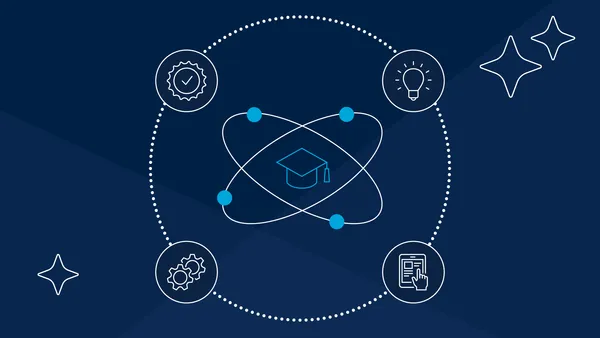This article is the first of a three-part series exploring the broader issues at play as higher ed debates proposed new rules governing topics such as online learning, emerging educational models and accreditation. Read the second and third installments.
A cool $6,630. That's how much Georgia Tech's online master's of computer science degree cost when it launched through MOOC-provider Udacity in 2014.
The low figure and big name of the university offering it raised eyebrows across higher ed at a time when much of online education was seen as a watered down and commoditized version of on-campus instruction.
Georgia Tech may have been testing the waters with its computer science degree, but other institutions soon followed in pursuit of ways to grow enrollment and compete in the burgeoning space. Five years later, colleges are offering a range of fully online credentials — and they continue to move beyond one-off programs.
The ongoing effort to scale is changing the way colleges bring online education to market. Online program managers (OPMs), which are behind a growing number of programs, are responding to colleges' desire for more flexibility and control in those relationships. They're also increasing the services they provide as a sector, while individual OPMs are honing specialties.
Those changes are piquing the interest of more colleges considering an outside partner to help them get and grow online.
Around 1,460 nonprofit colleges have some students who take only online classes, of which about 525 partner with an OPM to offer them, according to data from consulting firm Tyton Partners. While OPM-run programs report bigger enrollment growth than other online programs, those gains are slowing as competition heats up.
In 2013, online programs that used an OPM increased enrollment by 20.5%, compared to 3.7% for all nonprofit online programs. By 2016, those rates were 10.2% and 6.1%, respectively.
"We're in a chaotic period right now," said Michael Feldstein, a partner with ed-tech consulting firm MindWires. As colleges widen their focus to a broader swath of potential students, they also must choose from a range of online mediums and providers through which to reach them. Financial pressures, meanwhile, are both a catalyst and an inhibitor.
'We cannot be left behind'
The State University of New York (SUNY) is one of several public systems looking to raise its profile online. An early pioneer with its Open SUNY platform, the 64-campus system in July issued a request for information about how it could "take the next step in creating a comprehensive environment" for online learning within and beyond New York state.
The RFI puts a broad framework around SUNY's straightforward goals: reaching adult learners in New York; improving experiences for online-only students; drawing students away from other online colleges; aligning educational offerings with workforce needs; and turning online education into a revenue stream for campus operations.
The document, which Education Dive obtained, mentions a desire to "leapfrog competition" and "challenge current leaders in the field."
Such motivations at public institutions tend to be both revenue- and mission-driven, said Trace Urdan, a managing director at Tyton Partners. Resource-strapped colleges are looking to tap into the potential revenue stream of working adults, and they see strong markets within and beyond their borders. Some fear they are being beaten to these students on their own turf.
An email from system Chancellor Kristina Johnson to SUNY college presidents about the RFI points to that concern: "We cannot be left behind as other higher education institutions continue to innovate delivery of services to students. We see other systems and campuses across the country attracting millions of students and generating significant revenue."
Johnson lists a few examples: the nonprofit Southern New Hampshire University, California's new online community college and the nearby University of Massachusetts System.
A "more scalable and comprehensive approach is required," she wrote, "to catch up and ultimately surpass these programs."
SUNY Provost Tod Laursen characterized that stance as an attempt to show scale is possible. "We're to the point where we need to bring our faculties and institutions along a little bit and make sure they're comfortable with the approach we're taking," he told Education Dive. "If you accept as a premise that we can do more to scale our programs — and I do think our faculty and our administrators see that now — what is the right way for SUNY to do it?"
Open SUNY's enrollment is on the rise, with 177,441 students taking some or all classes online in the 2016-17 academic year, up 36% from 2011-12. Laursen said that figure is above 40% now. About one-third (34%) of Open SUNY students, or about 60,101 students, took only online classes during 2016-17, as compared to 38,776 students who did so in 2011-12.
However, Laursen notes, "well less than" 10% of all SUNY students take classes exclusively online. "That's the number we're looking to grow."
The University of Massachusetts, too, is expanding its online offerings to help draw out-of-state students in light of uncertainty over state funding and a projected decrease in the number of high school graduates. The University of Missouri system is also exploring an online learning overhaul.
"There really aren't any public institutions that aren't doing something online," Urdan said. "But they can, I think, objectively appreciate that they're not doing it at scale."
The colleges may have pedagogy down, but those looking to grow online are realizing the related technology and processes are less their domain as compared to institutions that made their names scaling online learning.
"I've sat in board rooms with trustees who say, 'It's impossible to provide a quality (online) education at that price point,'" Urdan said. "It's a hard conversation because I don't think it's impossible, but it may very well be impossible given the constraints that exist within the context of a public university."
Those constraints, or "points of friction" between how traditional campus-based and newer online-focused colleges operate, Urdan said, run the gamut of marketing, financial aid management and even determining the frequency of class starts.
"(Traditional colleges) have this challenge where they say, 'There's this audience, we're not serving them as effectively as these other models … (which) are doing things we can't really do, either because we don't know how or because we're not set up in a way to easily do it,'" he said.
Feldstein echoes that sentiment. "They're saying, 'We need to get to scale fast,'" he said. "In addition to internal financial drivers forcing them to look for other revenue sources, they're worried these big players may soak up market demand and that there won't be any room if they don't move quickly."
Laursen said it's too early to peg by how much SUNY expects to grow its share of online-only learners, though the system hopes this year to pilot scaling "at least a handful" of online programs across its campuses. Right now, he said, cohort sizes for online classes tend to be only around 30 students.
"In our case it might not be a horribly heavy lift to increase that number of full-time online learners simply because there are comparatively few now," he said. "We're thinking that with some tweaks we're going to make and some pilots we're going to run in the next few months, people will be able to explore some ideas. But we really do think we can be pretty aggressive in growing."
Teaching colleges 'how to fly'
SUNY is a "particularly visible" example of an institution making moves to address broadening online needs, Feldstein says. But it's not the only one. For help, public and private colleges of all sizes have turned to a crowded market of OPM partners.
Historically, colleges have offered OPMs a cut of tuition revenue in exchange for the resources needed to get an online offering off the ground quickly and without having to borrow heavily.
The online market has largely proven itself — one-third of students take at least one class online — so colleges are looking at it more strategically. As a result, many want to own some elements of the process and desire flexibility to shop around for new providers as their needs and available options change. Through an unbundled, fee-for-service model, colleges that don't need help generating capital to launch an online program may get more freedom from a shorter, tailored contract.
Some analysts have indicated revenue-share deals may be in peril as competition from the glut of OPMs drives down the cut of revenue universities are willing to offer, from as much as 80% a decade ago to between 50% and 60% today by some estimates. More programs going online, meanwhile, lowers tuition rates that can make the arrangements less lucrative for OPMs.
"If you accept as a premise that we can do more to scale our programs — and I do think our faculty and our administrators see that now — what is the right way for SUNY to do it?"

Tod Laursen
Provost, State University of New York
Fee-for-service providers, in turn, say their model positions the OPM as a consultant for the institution, rather than a one-stop-shop.
"OPMs over time are going to be more of a launching pad for universities, where they are brought in to provide expertise and resources, the ability to go to market quickly in a high-quality way," said Paxton Riter, co-founder and CEO of iDesign, an OPM that specializes in instructional design. "But you're kind of at the same time teaching universities how to fly."
A third option, brought forward by Noodle Partners, shifts colleges from a revenue-share to a fee-for-service structure once the program starts making money and the OPM can pay back its initial investment. That process can take about three to four years including time to develop the program, according to the company's founder, John Katzman.
Noodle's apparent success with the model is the "clearest example" of how the relationship between OPMs and colleges is changing, Urdan said. And it is expanding the number of colleges willing to consider an OPM arrangement.
"All of the OPM providers are seeing this and, if they haven't already, they are looking at adapting their approach to the market to be able to be flexible on this point," he said.
It's tempting to see this as a shift in the market, but Urdan and Feldstein caution viewing the current OPM landscape in absolutes. Still, there's evidence the expansion they identify is tied to colleges' push online.
The type of model a college and its OPM pursue ultimately depends on what the institution wants to achieve online and how it is positioned. Smaller colleges in need of startup capital may opt for a revenue share, while a college with a strong IT operations backbone may outsource other elements of the program like course design and financial aid on a fee-for-service basis. Elite institutions bent on carrying their strong brand equity into the online arena may be more inclined toward a revenue-share agreement with an OPM that can offer a high level of support across the board.
Finding flexible partners
OPMs say colleges are asking for more flexibility in these relationships.
George Mason University was flying mostly solo with its online programs before teaming up with Wiley two years ago. The large public research university in Virginia was seeing student interest grow in its online programs, particularly among working adults, and wanted to approach them more strategically, said Michelle Marks, the university's vice president for academic innovation and new ventures.
Working with Wiley, George Mason hopes to launch around 15 master's-level professional degrees and certificates. Last January, it added the first five of those programs, which included master's degrees in special education and health systems management and a graduate certificate in autism spectrum disorder. It followed with an MBA this past fall and a master's in data analytics engineering in the spring.
George Mason opted to work with an OPM to put higher-quality programs online faster than it could do itself. "In some cases like digital marketing, they're doing it better (than us)," Marks said. "In other cases, we simply needed the help to be able to move into the market at scale and at quality."
They're working through a revenue share, but that "doesn’t preclude" the ability to add services under other business models, Marks said.
Matt Hillman, co-president of Wiley Education Services and Learning House, has observed this trend more broadly. Although most colleges still opt to share revenue, "we're in a position where we can do a full revenue-share, we could do a co-investment model and we could do a fee-for-service model," he said. "The industry's evolving where (OPMs) need to be able to meet the school on their terms."
For its part, SUNY has so far worked with OPMs on an as-needed basis. But its online growth plans may require more consistent partnership, Laursen acknowledges. "We don't really see ourselves going with a full-bore OPM type of solution," he said, though contracting out some services "that they deliver to some of our competitors" could be helpful.
"It's early days for us," he said, "but we're kind of looking at a hyrbidized approach between contracting certain services and capabilities with the industrial sector but also building a little bit of muscle within our organization, too."
An acquisition may not be off the table, he said, but it's not the focus.
Growing services stack
The services offered by the OPM sector are broadening beyond marketing, enrollment and other administrative functions.
Career services and student success coaching for online learners are two programs colleges may increasingly hand over to OPMs. Penn State University's online World Campus, for example, works with educational services provider InsideTrack on a coaching program. The pair says the effort increased first-year retention by 3.6 percentage points and enrollment yield by 28%.
Meanwhile, undergraduate programs are expected to draw more attention as colleges build on their experience bringing graduate degrees and certificates online.
In responses to questions on its RFI, SUNY said the "largest opportunities for growth" are in bachelor's completion programs, professional master's degrees and microcredentials. (The vast majority of students enrolled in Open SUNY classes this fall were undergraduates.)
At least two OPMs are positioned to work with the undergraduate market.
Grand Canyon Education spun off its Grand Canyon University last year and is now its services provider. About 60% of the nonprofit college's some 83,000 students in the fall of 2017 were undergraduates, with two-thirds attending solely online.
And Pearson, an OPM for online powerhouse Arizona State University, is working with Maryville University, a private nonprofit near St. Louis that enrolled just under 8,000 students in the fall of 2017, to grow online — though, as Inside Higher Ed notes, it faces steep challenges to doing so.
"OPMs over time are going to be more of a launching pad for universities. ... But you're kind of at the same time teaching universities how to fly."

Paxton Riter
Co-founder and CEO, iDesign
Soliciting OPM services for ground-based and hybrid programs can help colleges present a unified face in the market when they offer both on-campus and online versions of a program. Wiley, for example, provides full-service marketing support targeting prospective students for George Mason's online and campus-based MBAs. That includes SEO, paid search, online advertising and social media.
"The dialogues (are) more and more moving toward broadening the services to be more than just about the fully online student (but) to be about the student at the university no matter what their modality," Hillman said.
That could lead to an uptick in blended and hybrid experiences, Riter predicts, where learners navigate instruction online and on campus.
"Over time there's going to be less difference between online and face-to-face education," he said. "It's just going to be education, and even face-to-face residential education that exists today is going to be much more technologically infused."
Of the online-only, face-to-face and blended learning modes, the latter is gaining the most traction across higher ed, according to Tyton Partners data. Its potential is particularly strong at four-year publics, with enrollment in blended offerings growing by 10% to 1.6 million students from 2014 to 2016, and by 6% across all institutions to 3.1 million students. That's compared to 2% growth (2.2 million students) overall for online-only programs during that time.
(It's worth noting that gains in online-only instruction slightly outpaced those of blended learning at two-year public campuses.)
Not a 'black box'
Low-cost graduate degree programs like Georgia Tech's remain a big part of online higher ed. But there are premium options, too, as well as shorter, stackable credentials and even undergraduate degrees. Across them all, transparency and flexibility on cost are expected to become more of a sticking point for colleges working with OPMs.
"There's not a black box," said Noodle's Katzman, who also founded 2U. "(Colleges) should understand who the vendors are we're using, why we're using them, what we're paying them and how we've integrated them into a coherent whole."
He expects the OPM-college relationship to become more "agile," with institutions focusing on what they're good at and seeking a partner for the rest. Questions remain, of course, on the extent to which colleges will be able to do that as regulators and industry representatives debate proposed new rules setting parameters for online higher ed that will guide future activity in the space.
The industry, however, continues to move forward online.
A shakeout in the OPM market is expected, and some see early signs of its arrival in Grand Canyon Education's acquisition of Orbis Education and Wiley's purchase of Learning House. Both deals added scale and more educational pathways for the companies.
For its part, SUNY wants to "scale to significant levels of new online students quickly," it said in responses to questions on its RFI — a process it hopes "will tell us what types of partners can help us do that."





















